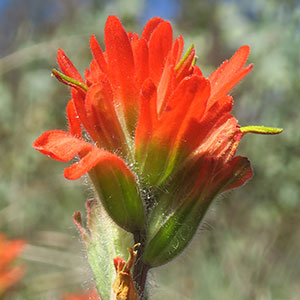Castilleja brevilobata
Castilleja mollis
short-lobed paintbrush
soft leaf Indian paintbrush, soft-leaf paintbrush
solitary or few, erect or ascending, unbranched, sometimes branched, hairs spreading, short, medium, and long, soft, short and medium ones short stipitate-glandular.
few to several, ± prostrate, sometimes ascending, much-branched, with dense, matlike growth form, often with short, leafy axillary shoots, hairs dense, tangled, short to long, fairly stiff, branched, sometimes glandular, white-woolly.
green or ± yellow, lanceolate, elliptic, or oblong to narrowly ovate, 1–2(–2.5) cm, not fleshy, margins plane or wavy, involute, (0–)3–5(–7)-lobed, apex rounded to acute;
lobes ascending to erect, linear to lanceolate, apex rounded to acute.
green to deep purple, narrowly elliptic to oblong, ovate, or obovate, 1–3 cm, ± fleshy, margins plane or ± wavy, flat, 0-lobed, apex rounded, rarely acute.
3–20 × 2–3.5 cm;
bracts proximally greenish to dull brown, distally red, orange-red, or scarlet, sometimes orange or yellow, broadly lanceolate or oblong, (0–)3–5-lobed;
lobes ascending, broadly to narrowly lanceolate, short, arising above mid length, apex acute, obtuse, or rounded.
usually erect, 2.5–8 × 1.5–4 cm;
bracts proximally greenish, distally pale to bright yellow, sometimes brownish orange, sometimes with brownish orange medial band, oblong, elliptic, or obovate, ± cup-shaped, ± fleshy, 0–3-lobed;
lobes erect, oblong, short, arising near tip, central lobe apex rounded to truncate, sometimes crenate or with obtuse teeth, lateral ones obtuse.
straight, 15–24(–26) mm;
tube 12–16 mm;
beak exserted, abaxial lip equal to calyx;
beak adaxially green or ± yellow-green, 7–10 mm, puberulent, stipitate-glandular;
abaxial lip deep green, reduced, rounded, 1–2 mm, 10–25% as long as beak;
teeth incurved to erect, light green, 0.5–1 mm.
straight, 17–26 mm;
tube 12–13 mm;
beak often slightly exserted, adaxially green to yellow-green, 11–13 mm;
abaxial lip green, reduced, 1.5–3.5 mm, 10–20% as long as beak;
teeth incurved, reduced, green, 0.5–1 mm.
green or whitish with green veins, lobes colored as bract lobes or paler, 14–30 mm;
abaxial and adaxial clefts 5.5–8.5 mm, 30–40% of calyx length, deeper than laterals, lateral 1.5–4 mm, 20–25% of calyx length;
lobes oblong to narrowly triangular, apex obtuse to rounded.
colored as bracts, lacking orange central band, 16–23 mm;
abaxial clefts 9.5–14 mm, adaxial 8 mm, abaxial 50–67% of calyx length, adaxial 35–45% of calyx length, deeper than laterals, lateral 4.5–5 mm, 20–25% of calyx length;
lobes oblong to triangular, abaxials sometimes wider than adaxials, apex acute to rounded, inner surface glabrous.
= 24.
= 24.
Castilleja brevilobata
Castilleja mollis
Castilleja brevilobata is endemic to dry serpentine openings in the Siskiyou Mountains of southwestern Oregon and adjacent California. Although sometimes treated as part of C. applegatei or C. hispida, its morphology does not suggest a close connection with either. This species occasionally hybridizes with C. pruinosa in Del Norte County, California.
(Discussion copyrighted by Flora of North America; reprinted with permission.)
Castilleja mollis is federally listed as a threatened species under the Endangered Species Act of the United States. It is endemic to the coastal terraces of the northern portion of Santa Rosa Island, Santa Barbara County, in the northern Channel Islands of southern California. It is recorded historically from San Miguel Island. Much of the available low-elevation habitat on Santa Rosa Island was degraded by trampling and grazing of introduced ungulates, which also resulted in the apparent loss of a natural population on the western end of San Miguel Island, last seen in the 1930s and now believed extirpated. Reports of C. mollis from the Oso Flaco Lake area of the mainland, in San Luis Obispo County, are based on populations of C. affinis var. contentiosa. Castilleja mollis is most closely related to C. latifolia of the central California coast and a sister species to the north, C. mendocinensis.
(Discussion copyrighted by Flora of North America; reprinted with permission.)


